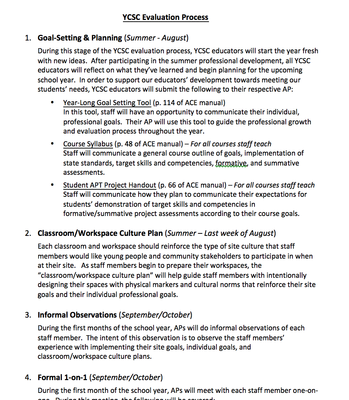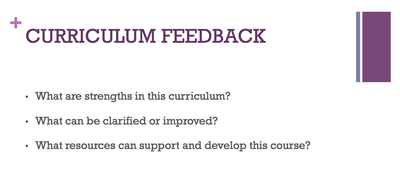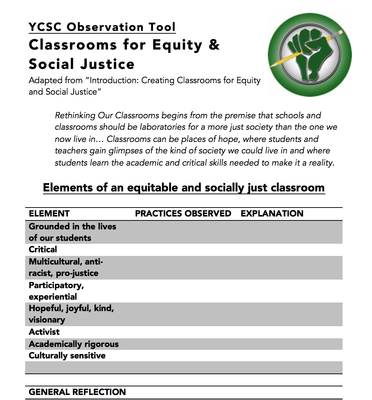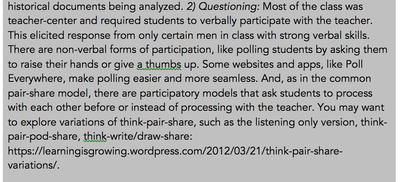Curriculum & Instruction
CURRICULUM & INSTRUCTIONS
As one of the Assistant Principal at YCSC, I evaluate and coach teachers in the design of their curriculum, their lesson delivery, and their professional growth. I work with 9 out of the 19 YCSC campuses. The school curriculum design was developed by a team of teachers and documented in the Authentic and Collaborative Education (ACE) Manual. Each trimester, I facilitate the completion of a number of processes outline in this manual:
- Essential question
- Community action project
- Course content
- Authentic performance tasks
- Professional goal-setting
After these documents are completed and submitted, I begin an evaluation and coaching process. At YCSC, each Assistant Principal follows year-long arc that we created over the summer. This process recognizes that teacher need regular feedback and support.
- Informal observation
- Formal 1-on-1
- Formal observation cycle
- End of the year reflection

CURRICULUM FEEDBACK
Teacher submit their curriculum documents each trimester. Either in an individual 1-on-1 or an e-mail, I provided instructors with feedback on their plans. Typically, I highlighted excellent practices and asked questions about areas that might need improvement. Finally, I always suggested a resource, a tool, reading, or practice that could support or enhance the curriculum. Often the curriculum feedback was given in the context of an informal observation, so I could see the lessons in practice.

CRITICAL FRIENDS
Each trimester, we ask teachers to complete a "critical friends "process with each other. The ACE Manual includes many forms that outline different critical friends formats that help teacher observe each other and give each other feedback. Once this process is completed, teacher will e-mail me their forms. This year, I responded by summarizing what was observed and asking simple questions to help them process their learning. Teachers gave me feedback that critical friends was difficult to organize. They had to find another teacher to cover their classroom. Or, teachers did not feel secure in having a colleague observe them. I tried to support them by discussing the importance of critical friends in the professional development process. Even so, critical friends does not take place as regularly as outlined in our school coaching process.

OBSERVATIONS
This year, at UCLA, I learned about different forms of democratic supervision. An article from Sullivan and Glanz described the rise of democratic models of supervision in the 1920s. Such models promoted cooperative problem-solving to educational issues. Clinical supervision, developed in the 1970s, follows a similar philosophy through its formalized approach. The supervisor and teacher create common goals. Then, the supervisor observes the teacher and provides feedback based on those goals. This year, in the late spring, I followed a clinical supervision model outlined by the Center for Technology Education at John Hopkins University. This involved 5 steps:
- Pre-observation conference
- Observation
- Data analysis
- Post-observation conference
- Post-conference
- Post-conference analysis
Additionally, I wanted my observations to focus on social justice educational practices. As such, I developed an observation form based on an article from Rethinking Schools that outlines 8 practices that create a "classroom for equity and social justice." Professor Merle Price, at UCLA, provided me with feedback on my observation methodology. He suggested on focusing my feedback on fewer elements, as too much feedback can overwhelm teachers and not allow them to focus their development on a few key skills. This intense observation process also takes much more time. All of my observations beginning in the late spring often took 2 days rather than 1. During the first day, I would meet with individual teachers to ask what skill or practice they would like to develop. Then, I would look at student work or achievement data. The next day, I would conduct my observations and meet individually with teachers. Then, I would write my analysis and e-mail it to the teacher.

The new observation form helped me focus on developing critical inquiry in teachers. I focused much of my feedback on culturally responsive techniques, the needs of language learners, culture of care, and issues of identity and power within the class. In one observation of a science class, I noted that student work suggested that several students struggled in writing short essay responses because of their lack of English language development. During the observation, I noted that the teacher did not provide enough questioning or verbal prompts to help the students articulate and develop their linguistic skills. I provided resources on science classroom questioning.

In another observation, I noted that only one female student was enrolled in the class. And, the only students participating in that lesson were male. The female teacher typically asked for participation through verbal interactions. I noted that studies indicate that verbal participation often prejudices males over females. During my conference with the teacher, she asked for alternative ideas for participation. I suggested think-pair-share, or small student-centered groups, as a practice that could support female student participation.

LEADERSHIP
During the curriculum feedback and teacher observation process, I was able to learn more about myself as a leader and develop new skills. These development align to the following CAPEs:
- CAPE 1: Developing and Articulating a Vision of Teaching and Learning for the School
-
CAPE 2: Developing a Shared Commitment to the Vision Among All Members of the School Community
-
CAPE 5: Promoting Implementation of K-12 Standards, Pedagogical Skills, Effective Instructional Practices and Student Assessments for Content Instruction
-
CAPE 6: Evaluating, Analyzing, and Providing Feedback on the Effectiveness of Classroom Instruction to Promote Student Learning and Teacher Professional Growth
-
CAPE 7: Demonstrating Understanding of the School and Community Context, Including the Instructional Implications of Cultural/Linguistic, Socioeconomic, and Political Factors
-
CAPE 9: Working with Others to Identify Student and School Needs and Developing a Data-Based School Growth Plan
-
CAPE 10: Implementing Change Strategies Based on Current, Relevant Theories and BestPractices in School Improvement
NEXT STEPS
During the summer, I would like to discuss with the other Assistant Principals how to use our observation and feedback process to encourage critical inquiry and reflections on positionality. The other Assistant Principals already include elements of those conversations, but we need to share best practices and set common goals. At UCLA, an instructed led an entire class session on critical friends models. I would like to think more about other models and integrate them into my school's practice. Additionally, I would like to see how my observation form can be adapted into the formal observation tool that we created last summer. Finally, I would like to address some of the challenges we as supervisors faced in regularly providing feedback to all of our staff members.

